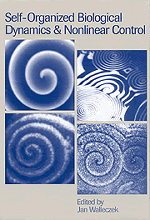 Self-Organized Biological Dynamics and Nonlinear Control
Self-Organized Biological Dynamics and Nonlinear Control Book contents
- Frontmatter
- Contents
- List of contributors
- Preface
- The frontiers and challenges of biodynamics research
- Part I Nonlinear dynamics in biology and response to stimuli
- Part II Nonlinear sensitivity of biological systems to electromagnetic stimuli
- Part III Stochastic noise-induced dynamics and transport in biological systems
- Part IV Nonlinear control of biological and other excitable systems
- 14 Controlling chaos in dynamical systems
- 15 Electromagnetic fields and biological tissues: from nonlinear response to chaos control
- 16 Epilepsy: multistability in a dynamic disease
- 17 Control and perturbation of wave propagation in excitable systems
- 18 Changing paradigms in biomedicine: implications for future research and clinical applications
- Index
18 - Changing paradigms in biomedicine: implications for future research and clinical applications
Published online by Cambridge University Press: 14 August 2009
- Frontmatter
- Contents
- List of contributors
- Preface
- The frontiers and challenges of biodynamics research
- Part I Nonlinear dynamics in biology and response to stimuli
- Part II Nonlinear sensitivity of biological systems to electromagnetic stimuli
- Part III Stochastic noise-induced dynamics and transport in biological systems
- Part IV Nonlinear control of biological and other excitable systems
- 14 Controlling chaos in dynamical systems
- 15 Electromagnetic fields and biological tissues: from nonlinear response to chaos control
- 16 Epilepsy: multistability in a dynamic disease
- 17 Control and perturbation of wave propagation in excitable systems
- 18 Changing paradigms in biomedicine: implications for future research and clinical applications
- Index
Summary
Introduction
A revolution is underway in the physical sciences, based on insights from nonlinear dynamics, which includes the areas popularly known as chaos and complexity studies. As described in the previous chapters, this revolution is beginning to affect greatly the biological and medical sciences as well. Prominent examples are the discovery of deterministic chaos in physiological time series data, of fractal properties of living processes, and of dynamical information processing in single cells and coupled cell signaling networks. The key feature of this work is the treatment of a living system as a dynamical system of nonlinearly interacting elements. As I have proposed in the Introduction to this book, the field of biodynamics might therefore be defined as the study of the complex web of nonlinear dynamical interactions between and among molecules, cells and tissues, which give rise to the emergent functions of a biological system as a whole.
This concluding chapter reviews major characteristics of this quickly developing research area and explores implications for basic research, clinical applications and biological thinking. Before highlighting selected findings that emphasize the nonlinear dynamical view, I first draw attention to the nonequilibrium foundations of living processes.
Life as a dynamical, nonequilibrium process
Many standard textbooks of cell biology or biochemistry still stress ideas that are based upon biochemical reaction-diffusion processes for equilibrium conditions in closed systems. Yet, we now know that the decay to biochemical equilibrium is a poor representation of living systems.
Information
- Type
- Chapter
- Information
- Self-Organized Biological Dynamics and Nonlinear ControlToward Understanding Complexity, Chaos and Emergent Function in Living Systems, pp. 409 - 420Publisher: Cambridge University PressPrint publication year: 2000
Accessibility standard: Unknown
Why this information is here
This section outlines the accessibility features of this content - including support for screen readers, full keyboard navigation and high-contrast display options. This may not be relevant for you.Accessibility Information
- 1
- Cited by